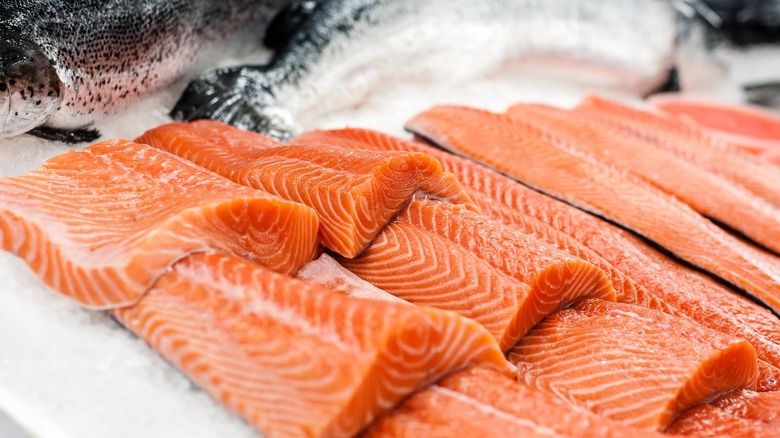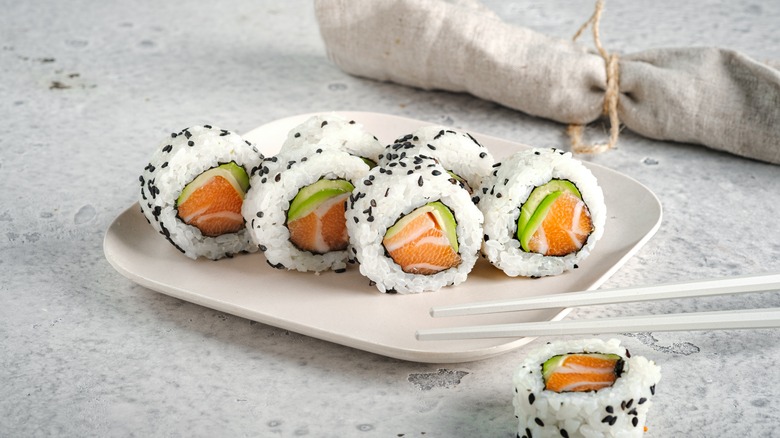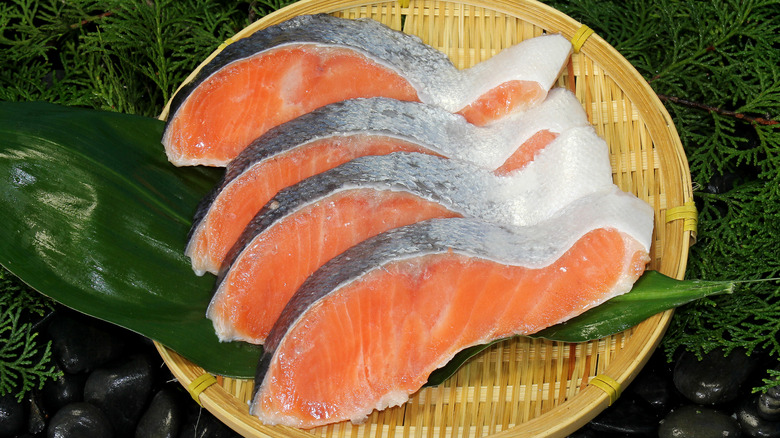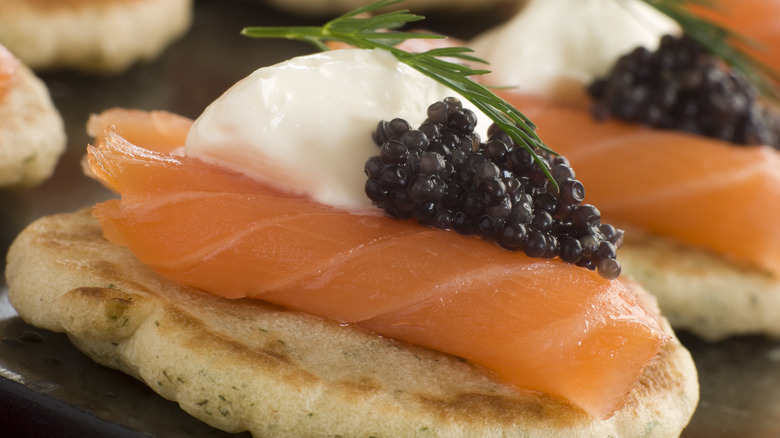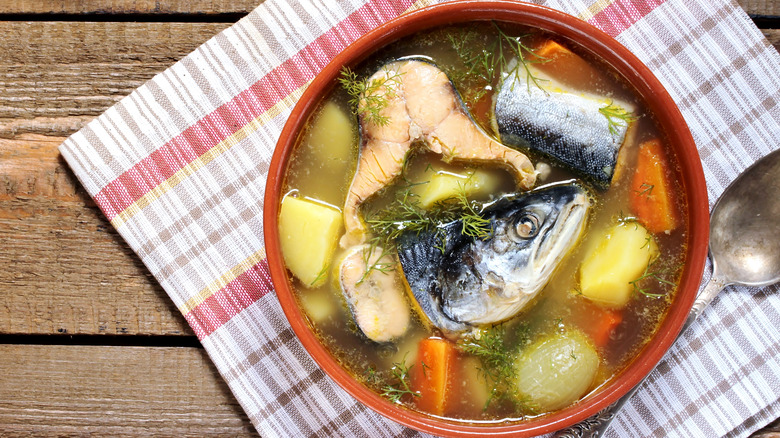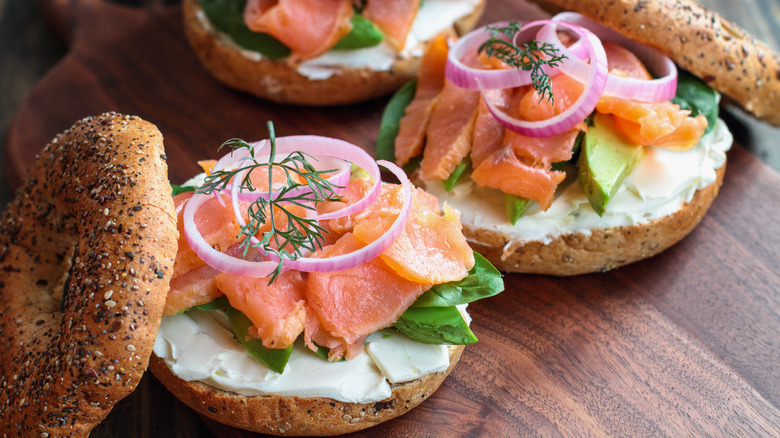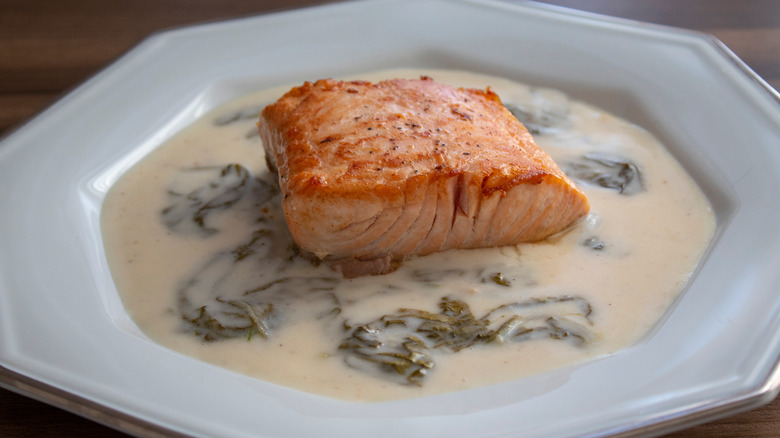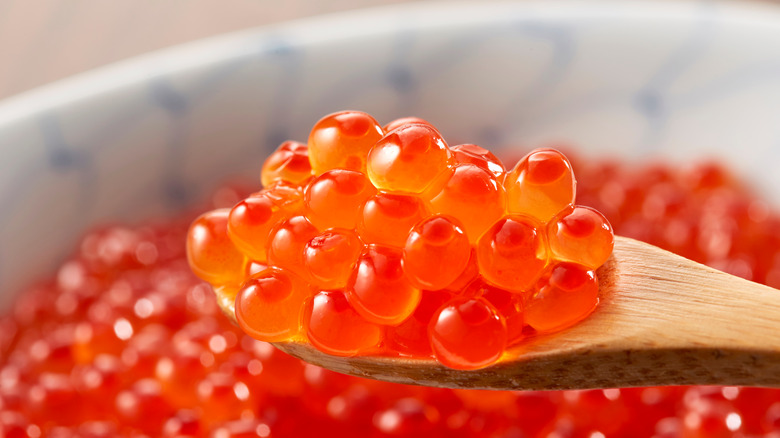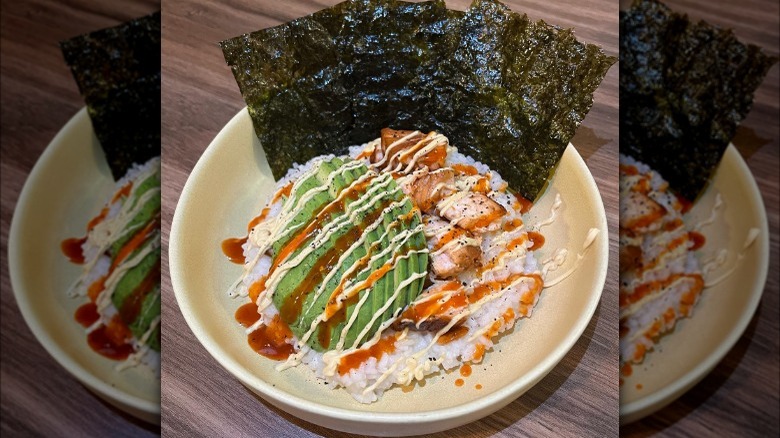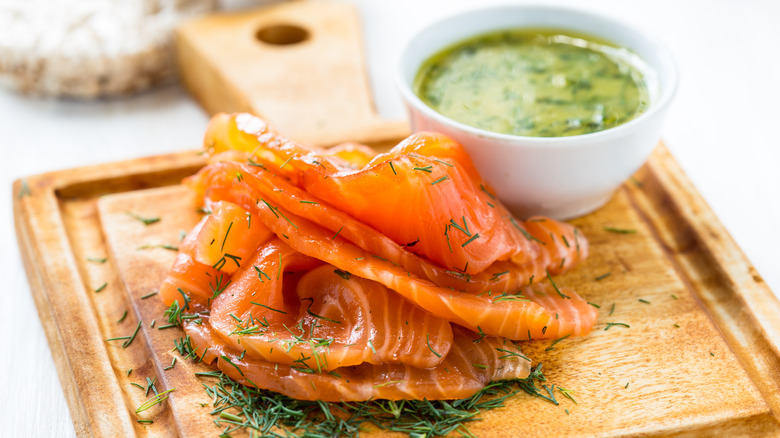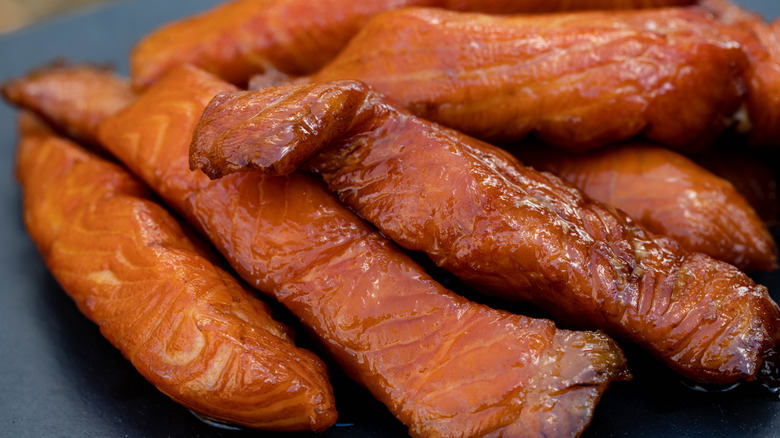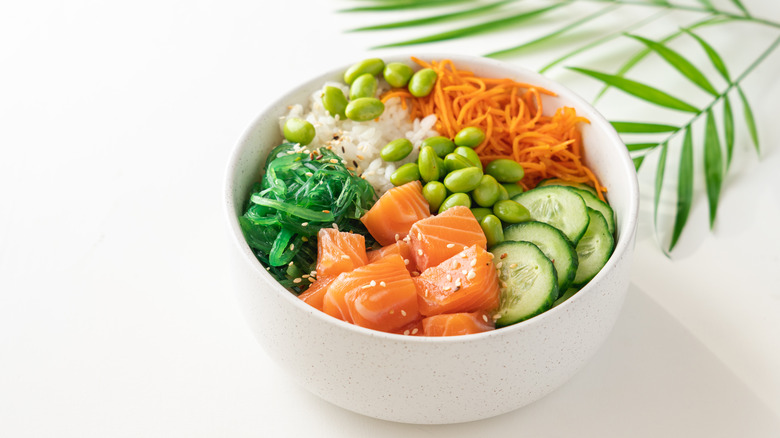11 Ways Salmon Is Enjoyed Around The World
If there's any succulent fish to sing songs for, it should be salmon. The pink fish is certainly worthy of an ode or two. But, first, we'd have to agree on what sort of salmon we're singing for. After all, there are eight total types of salmon from all over the world, with their own particular tastes, habitats, and looks. What they do have in common, however, is importance. Salmon are a keystone species directly linked to the health of the ecosystem they inhabit and have long been an important food source for humans.
Given the species' variety, it's hard to pin down an exact salmon taste. All salmon are oily, though they can vary between mild and bolder flavorings. As a rule of thumb, the lighter the meat of the salmon, the milder the flavor and vice versa. So, when it comes to salmon, there's something out there for everyone.
Salmon can be found naturally in coastal regions of both the Pacific and Atlantic. Of course, nowadays, they've also been a large part of aquaculture and have been farmed in diverse regions for widespread consumption. Salmon has only become more and more popular in cuisine as time goes by. It's only natural that there are different ways around the world that the fish is enjoyed. Below are 11 different ways people eat salmon around the world.
Raw (Sushi and Nigiri)
It's simply impossible to talk about salmon and not mention sushi. Who doesn't love a mighty salmon roll or even nigiri? But, the history of salmon and sushi is much more complicated and young than one might expect.
Of course, Japan has a long history of sushi making; the country invented it. But Pacific salmon, which is found in Japan, was traditionally never used for the raw fish delicacy. This was because the fish was regarded as dirty and known to carry parasites. Thus, it was a cheap filler fish that was either cured or cooked. It would take diplomatic intervention to bring the pink fish into the sushi roll.
That's where Norway comes in. By the '70s, the Scandinavian country had developed salmon farms that were capable of raising healthy, parasite-free fish and saw a potential market in Japan. But they had their work cut out for them. It wouldn't be until the '90s that salmon sushi began appearing on Japanese menus, and this was after the Norwegian fisheries organized advertisements, celebrity chef endorsements, and even a visit from the Norwegian Crown Prince and Princess.
Nowadays, salmon is a popular sushi choice in Japan due to both its mild yet rich taste and affordability. Norway wasn't only successful in exporting the fish to Japan but normalizing it in what may be the most competitive sushi scene on the market. For that, we can raise a roll to the salmon sushi roll that made its way to Japan via Norway.
Shiozake
We have become so accustomed to refrigerating our food that its accessibility is often overlooked. Before refrigerators, people came up with various ways of keeping their foods, especially meats, from spoiling. Those living in pre-modern inland Japan had to devise ways to keep their salmon edible over longer periods of time. One such technique they developed was shiozake, a heavily salted salmon. In some regions, shiozake would be made by salting the whole salmon, both inside and out. The heavily salted fish would then be hung and left to dry over the course of a few weeks. The finished product is called shiobiki and is regarded as an extremely salty version of shiozake.
Nowadays, despite improvements in refrigeration, shiozake remains very popular. Shiozake can be found as an onigiri filling, in a bento box, or even served up for breakfast. For those who would like to enjoy Japanese food with a lot of history, shiozake is simply like no other.
Balik-style Salmon
With large salmon populations in Russia, the country has long held the fish in high regard. The Tsarist family of Russia was especially fond of the oily fish and prized it as a smoked dish. The royal court loved smoked salmon so much that they even employed a so-called Imperial Court Smoker. While it may seem indulgent, it's hard not to respect the artistry of the resulting balik-style smoked salmon. For those unfamiliar, balik is what some, like Nanuk Salmon, call the "filet mignon" of salmon. It's hard not to see why, as Nanuk Salmon "starts with premium quality Atlantic salmon that is hand filleted and trimmed, leaving only the most flavourful centre." Afterward, the fillet is salted and cold-smoked, a unique process of smoking meats at a temperature no higher than 90 degrees Fahrenheit. What results is a salmon fillet that tastes buttery and raw, yet with all the rich flavors of smoke barbecue.
It's safe to say that balik is a luxury hand-made meat, which explains why a ½ pound can cost as much as $57 at specialists such as Shelsky's. When it comes to balik, most advise pairing opulence with opulence. Often Champagne, caviar, and blinis are recommended to join the royal salmon at the table.
Salmon Soup
The Haida Nation of British Columbia has long used salmon in its cuisine. After all, the fish is found in abundance there. Traditionally, the fish is caught with a spear or trawled with hemp-woven nets. Once caught, there are many ways to enjoy fresh salmon. Typically, just about every part of the salmon will be used and dried.
When made as a soup, salmon is regarded as a medicine for the flu, considering that it is chock-full of helpful vitamins. During flu season, some accounts say it's customary to gift salmon heads to loved ones and those who may be more sensitive to illness.
One man recalls in an article from Juneau Empire that as a child, he traded his grandpa a bag full of Halloween candy for some salmon heads and fondly shared stories of growing up with this truly one-of-a-kind food. For them, this heady soup was not just a home cure but also a beloved treat.
Lox
There's lots of love for lox, which some food historians believe is an American Jewish creation, or at least was popularized by American-Jewish communities. Esteemed cookbook author Claudia Roden traced lox back to turn-of-the-century America in her widely-praised book "The Book of Jewish Food". She notes that the salmon was uniquely affordable in the States, where abundant salmon from the West could be delivered easily to the East through the transcontinental railroad.
Lox was not only kosher but delicious. It's a unique style of salmon that was traditionally cured and made in an extremely pungent salt solution. Sources, such as The Smithsonian Magazine, speculate that this curing method was brought in through Scandinavian immigrants. Because of this particularly intense curing, lox didn't require the refrigeration that many, even into the 20th century, couldn't yet afford.
Nowadays, lox is more lightly cured, which means that you're best advised to pop the fish into the fridge after buying. Modern lox is not only less salty but also cold-smoked, which makes it just about interchangeable with smoked salmon. We'd be remiss to talk about lox without bringing in its tried and true companions: Bagel and cream cheese. The history of bagels and lox remains foggy, but most will agree that it's an American specialty that resulted from the auspicious mixing of culture and cuisine. Today it remains one of the most iconic breakfast foods Stateside.
Saumon à L'oseille
French cuisine is regarded by and large as producing some of the finest food around. While there are many different eras of French cooking, nouvelle cuisine is certainly worth getting to know, as it is the precursor to contemporary French cooking. The term nouvelle cuisine was first used by the now famous Gault-Millau restaurant guide, which saw a shift from the previous haute cuisine. The guide noted that food culture had revolutionized from complex dishes to lighter, more time-friendly dishes that emphasized health and taste over presentation.
It seems surprising that this so-called food revolution would occur, at least partially, outside of Paris, but it did. In the industrial town of Roanne, La Maison Troisgros, a family establishment run by two brothers, became the epicenter of nouvelle cuisine. The restaurant encapsulated the tenants of the nouvelle cuisine and pulled it off with aplomb.
There was one dish that truly put the family restaurant, which is still operational to this day, on the map: saumon à l'oseille. The dish is, per nouvelle cuisine, rather small and features a thin salmon fillet. The fillet is quickly pan-fried and met with sorrel leaves, white wine, and vermouth cream reduction. Once cooked, the dish is acidic, creamy, and light all at once, in short: heavenly. It remains to this day a hallmark of nouvelle cuisine and can still be ordered off-menu at La Maison Troisgros, which is now run under the name of Le Bois sans Feuilles.
Roe (Red Caviar)
Roe is technically both a biological and gastronomical term that refers to fish eggs. While caviar may be the most luxurious roe on the market, salmon roe is quickly gaining traction and is certainly something to appreciate. Some have even begun to refer to it as 'red caviar.' Salmon roe is not for those that are faint of heart or stomach: It is extremely bitter in comparison to other types of roe. Nonetheless, it does reward those who brave it with a distinct taste of salmon. Do keep in mind that the flavor profile of salmon roe can also vary depending on what variety of salmon it is sourced from.
Imperia Caviar recommends not overwhelming the delicacy and pairing salmon roe with soft cheeses, whose creaminess is sure to balance out the more astringent aspects of the salmon roe. But this needn't be the only pairing. Sushi lovers have probably at least seen ikura, a type of salmon roe often used to garnish sushi.
There are some major health benefits to salmon roe: It contains not only calcium but also antioxidants and omega-3 fatty acids. Some at the USDA found salmon roe to be perfect for children and even used it to make especially nutritious baby food.
Emily Mariko salmon rice bowl (Donburi)
TikTok is rife with culinary creativity, and dishes like Emily Mariko's salmon and rice bowl prove just why it may be the most exciting culinary app out there at the moment. The dish is simple, it utilizes crushed salmon with old rice. Mariko's twist is microwaving the rice and salmon bowl with an ice cube and sheet of parchment paper. There's a bit of genius to it, as the steam generated from them will lighten up old and clunky rice.
Afterward, the OG recipe calls for avocado and a drizzle of sauces: Ideally one hot and one creamy. While there's no explicit reference point for Mariko's modern creation, it is quite similar to donburi: A quick Japanese rice bowl that typically features meat and a variety of sauces.
As reported by the Know Your Meme, the dish was an instant hit and garnered over 3 million views in nine days. The dish has proven a smash for Gen-Z, and at the date of writing, the original TikTok had garnered over 7.8 million likes.
Gravlax
Salmon also plays a large role in Scandinavian cuisine, and nothing encapsulates this better than gravlax, a raw dish found on the ever-iconic smorgasbord. Gravlax is defined by a bold flavor that can only be achieved by heavily curing extremely thin slices of salmon. The name gravlax actually translates to "buried." Legend has it that back in the day, Nordic fishermen would salt and then bury salmon in the sand, and incoming tides would ferment the fish.
Sadly, this is no longer the way to make gravlax, but this style of salmon is still super yummy. In modern times, gravlax is marinated with a tantalizing mix of dill, salt, and even sugar. This process leaves the salmon both tender and flavorful, plus the remaining dry marinade can be used to make a supremely delicious sauce. Typically, gravlax is served on Christmas for lunch or dinner, but we'd like to think that this delicious dish is appropriate for any occasion.
Okanagan sockeye salmon
Way up north in British Columbia's Osoyoos Lake is a unique sockeye salmon that is known for its bold red skin that develops once the mating season starts. The fish feeds primarily on crustaceans and plankton, which Gastro Obscura believes gives it a "buttery" taste when cooked or cured. Perhaps it is because of this supremely decadent flavor that this salmon has long been made into candy by people indigenous to the region. Typically, the fish would be dried with sweeteners like sugar and salt.
For those that are curious to try the delicacy, the First Nation-run Authentic Indigenous Seafood offers to ship the candy internationally. In addition to sugars, their recipe uses wood smoke to add a smokey depth to the sweet yet savory trip. Additionally, the company promises to only use sustainably sourced salmon, which is important given that the species once experienced major overfishing. Once you've got your pack, the company suggests enjoying it immediately or bringing them as a travel snack on the trail.
Poké
Poké bowls have become mainstream in the last couple of years. But, really, they have been a traditional Hawai'ian dish with a long history. Of course, seafood has long played a large role in local cuisine for the islands. It's no shock that specialty curing processes would be developed to make the incredibly yummy poké bowl. Originally, fresh catches would be cured in salt and seaweed and then topped off with nuts before being enjoyed. Thus, the poké bowl was born.
As the island came into contact with more and more people, the dish began to evolve and reflect changing tastes, quite literally. Salmon isn't native to the islands but was introduced by way of trade. Sailors from the West Coast brought on board with them the pink and mild fish and were more than happy to exchange it for Hawai'ian specialty sea salt. Nowadays, salmon has been incorporated into Hawai'ian cuisine so fully that as poké bowls are popping up across the States, salmon is often an option on the menu or at the poké bar. Either way you cut it, salmon poké bowls beautifully reflect the way food can change and migrate over time.
